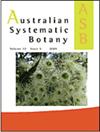Phylogenetic placement and the timing of diversification in Australia’s endemic Vachellia (Caesalpinioideae, Mimosoid Clade, Fabaceae) species
IF 1.6
3区 生物学
Q4 EVOLUTIONARY BIOLOGY
引用次数: 3
Abstract
Abstract. The genus Vachellia Wight & Arn. has a pantropical distribution, with species being distributed through Africa, the Americas, Asia and Australia. The relationships among the lineages from Africa and America are well understood, but the phylogenetic placement and evolutionary origins of the Australian species of Vachellia are not known. We, therefore, sequenced four plastid genes from representatives of each of the nine Australian species of Vachellia, and used Bayesian inference to assess the phylogenetic placement of these lineages, and a relaxed molecular clock to assess the timing of diversification. The Australian species of Vachellia form a well-supported monophyletic clade, with molecular-dating analysis suggesting a single dispersal into Australia 6.5 million years ago (95% range 13.9–2.7 million years ago). Diversification of the Australian clade commenced more recently, c. 3.1 million years ago (95% range 9.2–1.2 million years ago), perhaps driven by the increased aridification of Australia at this time. The closest relatives to the Australian Vachellia were not from the Malesian bioregion, suggesting either a long-distance dispersal from Africa, or two separate migrations through Asia. These results not only improve our understanding of the biogeography of Vachellia species, but also have significant implications for the biological control of invasive Vachellia species in Australia.澳大利亚特有Vachellia (Caesalpinioideae, Mimosoid枝,Fabaceae)种的系统发育定位和多样化时间
摘要Vachellia属,Wight & Arn。具有泛热带分布,物种分布在非洲,美洲,亚洲和澳大利亚。来自非洲和美洲的谱系之间的关系已被很好地理解,但澳大利亚Vachellia物种的系统发育位置和进化起源尚不清楚。因此,我们对来自9个澳大利亚Vachellia物种代表的4个质体基因进行了测序,并使用贝叶斯推断来评估这些谱系的系统发育位置,并使用宽松的分子钟来评估多样化的时间。澳大利亚的Vachellia物种形成了一个得到充分支持的单系分支,分子定年分析表明,它们在650万年前(95%范围为1390万至270万年前)曾一次分散到澳大利亚。澳大利亚进化枝的多样化开始于距今较近的约310万年前(95%范围为920 - 120万年前),可能是由于此时澳大利亚日益干旱所致。与澳大利亚Vachellia最近的亲戚不是来自马来西亚生物区域,这表明要么是从非洲长途迁徙,要么是两次通过亚洲的独立迁徙。这些研究结果不仅提高了我们对水蛭属植物生物地理学的认识,而且对澳大利亚水蛭属入侵植物的生物防治具有重要意义。
本文章由计算机程序翻译,如有差异,请以英文原文为准。
求助全文
约1分钟内获得全文
求助全文
来源期刊

Australian Systematic Botany
生物-进化生物学
CiteScore
3.10
自引率
12.50%
发文量
12
审稿时长
>12 weeks
期刊介绍:
Australian Systematic Botany is an international journal devoted to the systematics, taxonomy, and related aspects of biogeography and evolution of all algae, fungi and plants, including fossils. Descriptive taxonomic papers should normally constitute a comprehensive treatment of a group. Short papers on individual species and nomenclatural papers must contain significant new information of broader interest to be considered. The prestigious L.A.S. Johnson Review Series is published. Other review articles will also be considered. All papers are peer reviewed.
Australian Systematic Botany is published with the endorsement of the Commonwealth Scientific and Industrial Research Organisation (CSIRO) and the Australian Academy of Science.
 求助内容:
求助内容: 应助结果提醒方式:
应助结果提醒方式:


